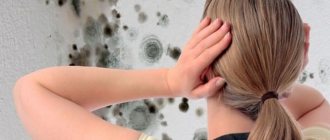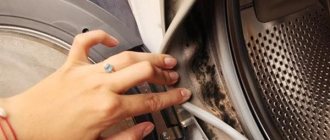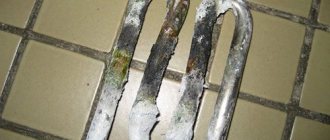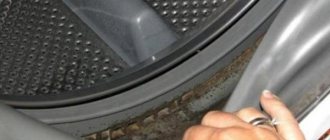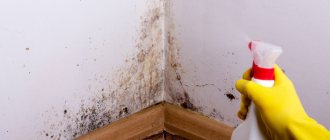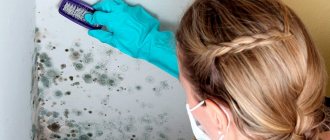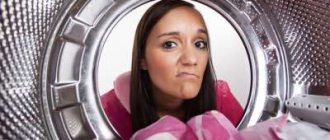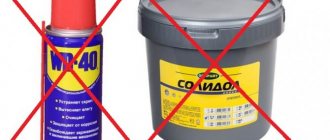- What is mold and what causes it?
- "Habitats" of fungus in a washing machine
- Cleaning the washing machine from mold using household chemicals
- How to clean mold from a washing machine using folk remedies
- How to get rid of fungus in a washing machine: secrets of removing mold from various elements
- “It’s easier to prevent than to treat”: preventing the appearance of fungus
- Finally
What is mold and what causes it?
At its core, mold is the simplest microorganism that reproduces by spores. In other words, it is a fungus. Dear reader may be surprised, but such spores live in absolutely any room, with the possible exception of medical offices that are regularly irradiated with an ultraviolet lamp. All that is needed for the spores to germinate is a favorable environment - warmth and dampness. And this is enough in the washing machine. In addition, housewives, without knowing it, often contribute to the growth of fungus by storing dirty things inside the drum or using too much powder, conditioner and other products. As a result, they are not completely rinsed out, settle on the walls and provide an excellent breeding ground for mold.
Why do you need to clean?
The rubber seal has a complex design with bends and folds. Dirt, hair, lint and debris accumulate in large quantities in the folds of the cuff - everything that was not removed through the filter and drain hose.
Due to the configuration, the rubber constantly maintains high humidity , which serves as an excellent environment for mold.
Attention! The remains of garbage are subject to rotting and mold infection, unpleasant odors and black spots appear - colonies of fungi and bacteria.
The musty smell not only creates an unfavorable atmosphere in the room, but also permeates washed clothes. Therefore, a responsible housewife should not have any questions about why the rubber band needs to be cleaned.
"Habitats" of fungus in a washing machine
There are 5 places in the machine that are most vulnerable to fungus:
- Container for detergents.
- Drum walls.
- In the door sealing rubber.
- In the hoses.
- Inside the filter.
Important!
It is necessary to clean the washing machine from mold. At the slightest manifestation of fungus (smell, mold), it is necessary to immediately begin fighting it. Otherwise, it will spread, which may damage the machine.
There are many different ways to get rid of mold in a washing machine. Let's try to understand each of them in detail.
Lemon acid
This is another budget-friendly product that will help deal with mold on the rubber band of your washing machine. I think every housewife has citric acid in her kitchen. You will also need any cleaning agent. I use Domestos. It is inexpensive and effective.
First you need to prepare your work surface. Wipe the elastic band thoroughly with a simple damp cloth. You can use a simple dishwashing sponge soaked in a mild soap solution. Try to remove all debris and dirt accumulated in the seal.
Next, apply Domestos or another household appliance cleaner to the rubber band. Take a damp cloth, dip it in the powder, and then go over the seal. Try to wipe all hard-to-reach places, otherwise the mold will return again.
Close the washing machine door tightly and leave for at least 2 hours. After this time, turn on the “Rinse” mode without removing the powder from the gum. Before turning on the washing machine, pour half a glass of citric acid into it. The temperature should be at its maximum. It is recommended to do this manipulation twice.
Cleaning the washing machine from mold using household chemicals
It is well known that chlorine is the best remedy in the fight against fungus, and therefore, when mold stains appear, any cleaning agent that contains it should be applied to them (information about this must be indicated on the label). The applied product should be left for a couple of hours and then rinsed off. There will be no trace left of stains after this procedure.
Methods for cleaning dirt
Since rubber is a soft material, it is better to choose more gentle products in the form of gels and liquids. Powder and abrasive compounds thin the material and cause rapid wear of the rubber, and mechanical methods can damage it.
The easiest and safest option is to wipe the cuff with a sponge soaked in dishwashing detergent. This will not only remove dirt, but also give a fresh, pleasant aroma.
If the stains are persistent, this composition will do. A shaving of laundry soap, a drop of dishwashing detergent and a drop of bleach are diluted with a small amount of water and foamed. All this is applied to the cuff and left for several hours, after which the idle wash mode and double rinse are turned on. Finally, the rubber is wiped with a clean cloth and dried.
There is a special liquid machine cleaner designed for the highest quality cleaning. A special dishwasher cleaner will have the same effect.
How to clean mold from a washing machine using folk remedies
Citric and acetic acid, as well as soda, work very well in the fight against fungus. The vinegar can be diluted a little and applied to problem areas, and washed off after half an hour. Citric acid or soda is poured into the drum, after which a dry wash cycle is performed, without laundry. But first things first.
Choice of product
A variety of household chemicals are suitable for caring for the sealing cuff of an automatic machine. It is important that they not only have bleaching, deodorizing and cleaning properties, but also be able to cope with mold and bacteria.
Is there mold in your washing machine?
Not really
Baking soda
Use soda to clean the cuff manually - a self-prepared gruel or soap solution will do. In the first case, 2-3 tablespoons of soda are combined with a small amount of water to obtain a paste.
Apply the product to a kitchen sponge and wipe the gum around the entire perimeter, carefully treating the inner surface.
The second option is to mix a spoonful of baking soda with gel or dishwashing liquid . A soap solution works in the same way - apply to dirt and scrub thoroughly. You need to let the soda act for a while (about half an hour), and then rinse off the remaining substance with clean water.
Important! During the washing process, it is forbidden to stretch the elastic band too much, otherwise the seal of the automatic machine will be broken.
Antibacterial and chlorine-containing agents
This group of products includes household chemicals containing disinfectant additives to eliminate bacteria, viruses and mold. They do not have to be designed specifically for the washing machine.
Universal products for caring for plumbing fixtures, tiles, and work surfaces in the kitchen are suitable:
- “Toilet duckling”;
- “Domestos”;
- Sanfor;
- Neomid;
- Cillit Bang;
- Mildew remover;
- Veksa;
- Vanish.
Advice! Choose the release form that is convenient for you - spray, gel or liquid. The drug is applied to the gum with a washcloth or a damp cloth, and after 30-60 minutes it is washed off along with the dirt.
Copper sulfate
Copper sulfate pentahydrate is especially popular among summer residents for controlling pests of trees and shrubs. In everyday life, the antiseptic, antifungal and disinfectant properties of the liquid are also useful.
How to wash properly:
- Prepare a cleaning solution - 30 g of substance per 1 liter of clean water.
- Soak a rag or washcloth in the liquid and treat the cuff without missing a centimeter.
- Leave the drug to “work” for about a day.
- After a day, turn the machine on to the quick wash mode.
- At the end of the process, wipe the gum dry and leave the door open so that the surfaces are completely dry.
How to get rid of fungus in a washing machine: secrets of removing mold from various elements
It is clear that visible mold is much easier to remove than that which is hidden. This means that it is worth considering the various elements on which it can form in more detail. Let's look at the options for removing fungus from:
- rubber bands around the hatch;
- powder tray;
- from inside the drain hose;
- from inside the drum.
And then, having considered all these options, we will try to summarize all the information.
How to remove mold stains from a washing machine seal
If you find mold stains on the cuff of your washing machine, do not panic; they are easy to remove. A solution of citric or acetic acid is suitable for this. Wet the stain generously with a soft cloth and leave it for a while. Usually half an hour is enough. After this, wash the seal with a non-aggressive detergent and dry it. Of course, it is best to dry under ultraviolet rays, but not everyone has this opportunity, and therefore you need to try to ensure that there is no dampness in the room where the machine is installed during drying.
Important!
The fungus is not always removed the first time. If even barely noticeable spots remain after the procedure, it should be repeated. Otherwise, all the work will be in vain - the fungus grows very quickly.
How to clean mold from a washing machine tray
This is quite easy to do. If black mold appears in the powder tray of your washing machine, you can get rid of it as follows. We take out the tray (you can read how to do this in the instructions for the device) and wash it with a detergent containing chlorine. If there is a lot of mold, it makes sense to soak the tray in a solution of vinegar or citric acid for 2-3 hours, then rinse thoroughly and dry. It is better to dry in the sun - it will kill the remaining spores. A fairly effective means for destroying the remaining fungus is a quartz lamp. If it is in the house, then it is better to dry it under it.
Another way to clean the tray is for those who don’t want to wait for the mold to soak. To clean, you will need a toothbrush and baking soda. Sodium bicarbonate (soda) is slightly diluted with water until it becomes mushy. Using this solution, use a toothbrush to scrub off the mold from the tray and rinse with water. Now all that remains is to dry the tray and put it in place.
Getting rid of unpleasant odors: cleaning hoses from fungus
To clean the hoses you will need 400 ml of vinegar. We pour it into the machine, and then start the normal washing cycle without items. The main thing here is to monitor the time, when the process approaches the moment of draining, the program must be stopped and left for 15-20 minutes. Next, we launch the program again and wait for the water to drain. The hoses will be washed, but now you need to get rid of the vinegar smell. To do this, add 2-3 tbsp to the machine. l. baking soda and run the “empty” wash cycle again. It should go all the way (of course, you can do without spinning). After this, the damp smell from the washing machine will disappear.
Mold smell in the washing machine: how to get rid of it if there are no visible stains
If there are no obvious colonies of fungus visible visually, then most likely mold is growing in the drum. It can be cleaned in two ways. Let's start with whiteness. To prevent the washing machine from smelling like mold, pour a liter bottle into it and set it to the maximum time and temperature. We turn on the cycle and wait for it to end, no further actions are required.
The second way to clean a washing machine from mold is to use citric acid. Pour 400 g of lemon juice into the tray and turn on the device at maximum temperature. After 60 minutes, set it to rinse and drain mode.
Mold in the washing machine: how to get rid of fungus in filters
The first thing to do is turn off the water supply tap and unscrew the hose. In this case, you should be careful - pressure remains in the water supply hose even when the tap is turned off. Afterwards, large contaminants are removed using tweezers, and the mesh is wiped with vinegar or bleach. You need to do the same with the drain hose filter.
How to clean a car under the rubber
It is no secret that the rubber band can be removed completely and the surface underneath can be thoroughly washed. The scheme is simple:
- It is necessary to use a screwdriver to pick up the clamp on which the rubber cuff is attached
- You need to remove the clamp, carefully use a screwdriver in a circle
- Next, you can remove the rubber cuff
- Wash off any visible dirt from the gum with water.
- Soak the seal in a chlorine-containing substance
- Dry the part and put it back.
If you have difficulty removing the rubber band, but need to clean it, you can call an equipment maintenance specialist.
Complete washing machine cleaning procedure
You can completely clean your washing machine using citric acid.
- You will need several packs of citric acid (which depends on the loading volume of the machine)
- Pour the acid into the washing powder compartment.
- Run the machine at maximum speed for a long wash.
The acid will clean the machine of scale and also get rid of foreign odors.
“It’s easier to prevent than to treat”: preventing the appearance of fungus
In order not to think later about how to remove mold from a washing machine, you need to follow some rules for its operation. Here are some recommendations from the editors that will help the dear reader in this matter:
- Do not leave laundry in the drum for a long time after washing. After finishing washing, it must be taken out immediately.
- After turning off the power, wipe the drum and seal dry, remove, rinse and dry the tray.
- When using fabric softener, do not exceed the dosage indicated on the package.
- Do not close the door tightly - this will prevent the machine from drying out inside.
- Make sure there is good ventilation in the room where the device is located. A forced ventilation device would be useful.
- Once every 2-3 months, wash the machine with citric acid at maximum temperature.
If you follow these simple tips, then the question of how to remove the smell of mold from a washing machine will not arise in principle.
Why does mold appear on the hatch seal?
If after washing the laundry smells damp and dirty gray spots appear on it in places, it means that mold has settled in the machine. A similar problem arises due to high humidity and lack of air exchange, as well as poor hygiene. You are at risk of encountering it if:
- Always run the wash in delicate or fast mode. The water heats up to 30–40°C, which is not enough to kill bacteria and fungal spores - microorganisms settle on the inside of the drum and hatch.
- Use conditioner or other rinse aid every time. The softening components contained in these products are not washed off from plastic, metal and rubber surfaces. They form a slimy coating in which mold actively multiplies.
- Leaving wet clothes inside the washing machine for a long time. Dampness, cold and lack of fresh air are ideal conditions for the growth of fungi, so things should be removed from the drum immediately, or at least 2-3 hours after the end of washing. If you can’t hang the laundry right away, put it in a basin.
- Close the hatch when there is water left inside the drum. High humidity combined with low temperature promotes the accelerated development of mold colonies. The hatch should be left slightly open until the machine is completely dry.
Before you start fighting mold, you need to understand what exactly led to its appearance. After all, if the root cause is not eliminated, fungal plaque will appear again and again.
If all else fails
Unfortunately, in reality there are such advanced cases that none of the presented methods helps eliminate mold on the elastic of the washing machine. In such a situation, there is only one effective method - replacing the seal. With this question, it is better to contact a special service department, where qualified craftsmen will get down to business.
If you decide to replace the rubber band on your washing machine yourself and do something incorrectly, this may cause a leak, which will negatively affect the further operation of the equipment.
Mold is an unpleasant sight no matter where it appears. However, few people know that such a fungus can be very dangerous to human health. And if it forms on a washing machine, then this only aggravates the situation. Fortunately, it can be eliminated with the help of ingredients that we often use in everyday life. And if you then adhere to preventive measures, then you can forget about mold forever.

